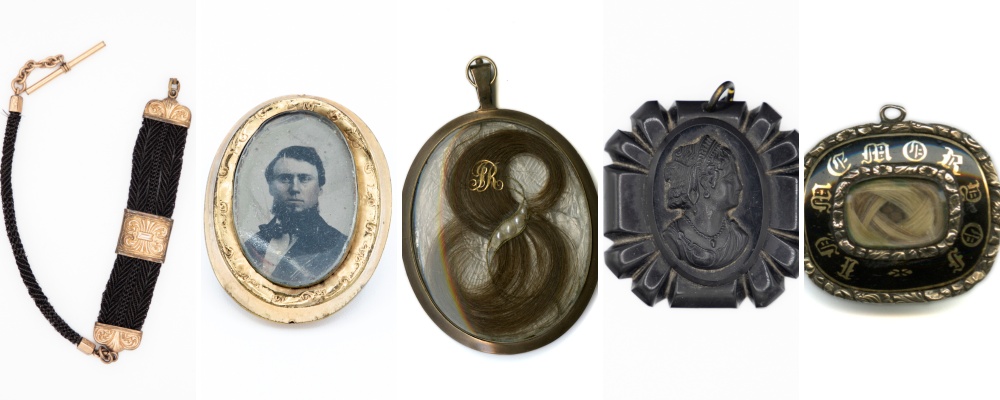Blog
Remembering a Loved One: Mourning Jewelry
October 01, 2024

Artist Unknown, Watch Chain, woven hair and gold hardware,
ca 1860-1865, 2021.33.1611.
Artist Unknown, Brooch with Tintype, tintype, and gold, ca
1865, 2021.33.1619
Caroline Schetky Richardson, Portrait Necklace of J.
Richardson, watercolor on ivory, hair, pearl, ca 1800, L11.2022.1076.
Artist Unknown, Cameo Pendant, gutta-percha, ca 1855-1860, 2021.33.1614.
Artist Unknown, Hair Brooch, sterling silver and gold, hair,
black enamel, ca 1780, L11.2022.1081.
Throughout human existence, different cultures have established ways to honor their deceased loved ones. One way is through remembrance or mourning jewelry, which can be traced back to Ancient Rome. Examples of jewelry with incorporated bones and teeth, along with colorful gems and metals, have been found in many Roman archaeological sites. These early jewelry examples may have been made in remembrance of an individual, mark status or rank, or represent a form of protection or luck.
Memorial jewelry became commonly associated with the British Victorian Era (1837-1901), especially after the death of Prince Albert, Queen Victoria’s husband, in 1861. Queen Victoria wore black for decades after his death, also setting a trend in black fashion jewelry for mourning. Jewelry included rings, lockets, bracelets, and necklaces, ranging in mediums from jet, a form of fossilized coal, to pearls, ivory, black enamel, glass, or gemstones. Some mourning jewelry is simply black, others have names of loved ones engraved on metal, and others include tokens of the deceased.
Also during the Victorian Era, hair memorial jewelry grew in popularity. Hair was incorporated into jewelry in different ways; added as a symbol of love, friendship, or in memoriam. Hair jewelry was professionally created or crafted by hand. It was created from both human and animal hair. Bracelets or rings were made from braided and woven hair with added metal decorations and closures. Some necklaces or pendants would include a painted (later photographic) portrait of a loved one, with hair in a glass locket on the back of the pendant.
In the United States, hair jewelry became more common at the beginning of the Civil War. Soldiers would often leave a lock of hair with their family to be kept safe in a locket or brooch, or a soldier’s loved one would send a lock of hair along with them as a reminder of their family on the battlefield. The lockets often included an image of the soldier and would be worn for months during the mourning process for those soldiers who did not return home. Many historians believe that the increasing popularity of “short bob” style haircuts for women, and the gains in women’s rights, slowly made hair jewelry less desirable.
The GVSU Art Museum Collection has several examples of mourning jewelry, including examples with both human and animal hair. While these pieces represent a fascination often found with the macabre, we also want to respect and honor those for whom these pieces of art were crafted and those they memorialize.
Explore more mourning jewelry in the collection.
Contemporary artists and jewelers continue the tradition of creating mourning jewelry still to this day. The GVSU Art Museum Collection has an example by local Grand Rapids artist, and GVSU Professor, Renee Zettle-Sterling. For her piece, Objects of Mourning Liminality, Zettle-Sterling created one mourning brooch every day for a year after the passing of her brother. Many of the brooches she created reference Victorian Era style.
Explore more about Objects of Mourning Liminality.
Artist Unknown, Watch Chain, woven hair and gold hardware,
ca 1860-1865, 2021.33.1611.
Artist Unknown, Brooch with Tintype, tintype, and gold, ca
1865, 2021.33.1619
Caroline Schetky Richardson, Portrait Necklace of J.
Richardson, watercolor on ivory, hair, pearl, ca 1800, L11.2022.1076.
Artist Unknown, Cameo Pendant, gutta-percha, ca 1855-1860, 2021.33.1614.
Artist Unknown, Hair Brooch, sterling silver and gold, hair,
black enamel, ca 1780, L11.2022.1081.
